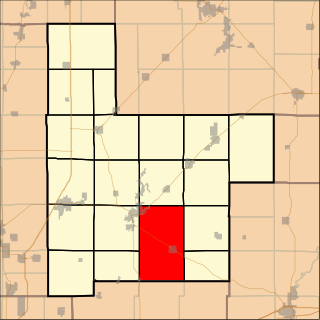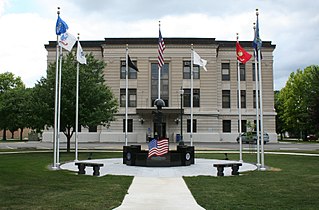
The United States presidential election of 1852 was the seventeenth quadrennial presidential election, held on Tuesday, November 2, 1852. Democrat Franklin Pierce, a former Senator from New Hampshire, defeated General Winfield Scott, the Whig nominee. This was the last election in which the Whigs served as the principal opposition to the Democrats.

The United States presidential election of 1856 was the 18th quadrennial presidential election, held on Tuesday, November 4, 1856. In a three-way election, Democrat James Buchanan defeated Republican nominee John C. Frémont and American Party nominee Millard Fillmore.

Montgomery County is a county located in the U.S. state of Illinois. According to the 2010 census, it had a population of 30,104. Its county seat is Hillsboro.

Fillmore County is one of 93 counties in the U.S. state of Nebraska. As of the 2010 United States Census, the population was 5,890. Its county seat is Geneva. The county was named for President Millard Fillmore.

Fillmore County is a county in the U.S. state of Minnesota. As of the 2010 United States Census, the population was 20,866. Its county seat is Preston.

Fillmore is a village in Montgomery County, Illinois, United States. The population was 362 at the 2000 census.

East Fork Township is located in Montgomery County, Illinois, United States. As of the 2010 census, its population was 2,566 and it contained 1,093 housing units.

Fillmore Consolidated Township is a township located in Montgomery County, Illinois, United States. As of the 2010 census, its population was 616 and it contained 290 housing units. In 2016, Fillmore Township and South Fillmore Township voted to merge into Fillmore Consolidated Township.

South Fillmore Township was a civil township of Montgomery County, Illinois, United States. It consisted of the northern two-thirds of survey Township 7 North, Range 2 West of the Third Principal Meridian. It was split from Fillmore Township in 1921, and annexed back into Fillmore Township in May 2017.

Bourbon Township is one of nine townships in Douglas County, Illinois, USA. As of the 2010 census, its population was 4,124 and it contained 1,352 housing units.

The presidency of Millard Fillmore began on July 9, 1850, when Millard Fillmore became President of the United States upon the death of Zachary Taylor, and ended on March 4, 1853. Fillmore had been Vice President of the United States for 1 year, 4 months when he became the 13th United States president. Fillmore was the second president to succeed to the office without being elected to it, after John Tyler, as well as the last Whig president. Fillmore was succeeded by Democrat Franklin Pierce.

Millard Fillmore was the 13th president of the United States (1850–1853), and the last to be a member of the Whig Party while in the White House. A former U.S. Representative from New York, Fillmore was elected the nation's 12th vice president in 1848, and succeeded to the presidency in July 1850 upon the death of President Zachary Taylor. He was instrumental in getting the Compromise of 1850 passed, a bargain that led to a brief truce in the battle over slavery. He failed to win the Whig nomination for president in 1852; he gained the endorsement of the nativist Know Nothing Party four years later, and finished third in that election.

Stephen Arnold Douglas was an American politician and lawyer from Illinois. He was the Democratic Party nominee for president in the 1860 election, but he was defeated by Republican candidate Abraham Lincoln. Douglas had previously bested Lincoln in the 1858 Illinois election for the United States Senate, which is known for the Lincoln–Douglas debates. During the 1850s, Douglas was one of the foremost advocates of popular sovereignty, which held that each territory should be allowed to determine whether to permit slavery within its borders. Douglas was nicknamed the "Little Giant" because he was short in physical stature, but a forceful and dominant figure in politics.

Chapman is an unincorporated community in Fillmore Township, Montgomery County, Illinois, United States. Chapman is located on County Route 9, 2.2 miles (3.5 km) west-southwest of Fillmore.

Van Burensburg is an unincorporated community in South Fillmore Township, Montgomery County, Illinois, United States. Van Burensburg is located on Illinois Route 185, 11.3 miles (18.2 km) west-northwest of Vandalia.

The 1856 United States elections elected the members of the 35th United States Congress. The election took place during a major national debate over slavery, with the issue of "Bleeding Kansas" taking center stage. Along with the 1854 election, this election saw the start of the Third Party System, as the Republican Party absorbed the Northern anti-slavery representatives who had been elected in 1854 under the "Opposition Party" ticket as the second most powerful party in Congress. Minnesota and Oregon joined the union before the next election, and elected their respective Congressional delegations to the 35th Congress.

The 1852 United States elections elected the members of the 33rd United States Congress. The election marked the end of the Second Party System, as the Whig Party ceased to function as a national party following this election. Democrats won the presidency and retained control of both houses of Congress.


















